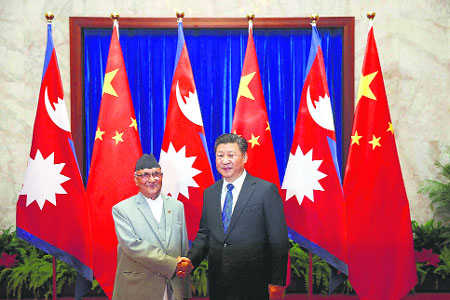The most worrisome aspect of China-Nepal partnership for India is the emerging synergy on railway connectivity. China and Nepal are moving firmly towards finalising agreements on some key railway projects.

Bhartendu Kumar Singh
Indian Defence Accounts ServiceSoon after his India visit, Nepal Prime Minister KP Oli packed off his Foreign Minister Pradip Gyawali to China. While Oli returned from New Delhi with a basketful of projects and assurances, Beijing is luring Nepal with a bigger basket. Gyawali had gone to prepare grounds for Oli’s Beijing visit. Nepal, it seems, is making a clear but incremental shift towards its northern neighbour. In doing so, it is changing the geographically determined inclination towards New Delhi. At a psychological level, Nepal is integral to ‘spatial idea of Indianness’ if not the political idea of India. The border is irrelevant and incontexual in regulating each other’s citizenry’s behaviour, guided by historical and sociological connections as propellents. The psychological feeling is more confederational than international, challenging the very concept of ‘territorial consciousness’ of modern states. Cross the open border and the homogeneity of affiliations is visible in language, kinship and a cobweb of relations overriding the national barriers. It simply does not feel like a different country! However, the India-Nepal border also affirms Charles S Maier’s hypothesis (Once Within Borders; Harvard University Press, 2016) that views frontiers as ‘reflecting steep gradients of inequality and zones of differential privileges’. Unlike India, Nepal is an example of political instability and economic stagnation. Partly, it is because Nepal has not allowed easy diffusion of ideas, institutions and practices that make India a vibrant democracy and an emerging economic power. Additionally, the local politics in Nepal is fueled by anti-India semantics. India perhaps is a victim of ‘power paradox’ in Nepal where it has spent billions without achieving its larger strategic goals. This ‘relationship of paradox’ is getting wider due to Chinese geographical overtures. Whispers from Beijing indicate that China is bringing Nepal within the Belt and Road Initiative (BRI) with $7-8 billion investments. Wang Yi, Chinese Foreign Minister, has proposed a China-Nepal-India economic corridor as part of the BRI for common development of the Himalayan region. Nepal also feels that the proposed BRI encompassing cross-border roads, railways, oil pipelines, information highways, energy grids, skyways and transmission highways could improve the quality of lives in the hill state. However, from an Indian perspective, the proposal could bring Nepal under the ‘Chinese sphere of influence’ through the positioning of Chinese men, material and money on permanent basis. Probably, the most worrisome aspect of China-Nepal partnership is the emerging synergy on railway connectivity. China and Nepal are moving firmly towards finalising agreements on some key railway projects. The two foreign ministers discussed conducting a feasibility study for the proposed Nepal-China Cross Border Railway from Keyrong to Kathmandu, and from Kathmandu to Pokhara and Lumbini. One is not sure if the statement by the Nepal Foreign Minister was a pleasing one made in passing, but certain inferences deserve mention. 1First, China has the expertise to build high-altitude railways in Tibet and is gradually extending them southwards towards Nepal. Connecting Nepal should not be a major technical problem. China is also known for completing its railway projects in time; so it should not take much time once the detailed project review (DPR) is available. Beijing has already sent its first railroad freight express to Kathmandu, opening up possibilities of expanded trade and commerce between the two sides. 2Second, Lumbini is bang in the Terai zone, near the Indo-Nepal border. Any railway project with Chinese assistance may undermine India’s established influence in the southern part of Nepal. It also shows that Nepal, under Oli, a known China supporter, would not hesitate to play the China card in its southern part even if it means compromising India’s interests. Nepal is turning its geographical limitations into advantages. 3Third, in the geographical game, India is losing out to China with Nepal increasingly relying on the latter. More and more projects in Nepal are going the Chinese way with Chinese footprints everywhere. One example would suffice. The buses plying from the border cities of Nepal to Kathmandu are of ‘Higher’ company of China than the Indian make earlier. As Robert D Kaplan hypothesises (The Revenge of Geography, 2013), “India’s advantages and disadvantages as it seeks great power status in the early twenty-first century lie in its geography. India is yet to dominate its high-altitude shadow zone (ie like Nepal), so that India remains the lesser power.” New Delhi, to use Teresita C Schaffer and Howard B Schaffer’s euphemism, “can no longer exclude Chinese influence from its smaller neighbours but can instead serve its interests better by altering its tactics.” India, therefore, needs to adopt smart power narrative and forge greater convergence, making Nepal a volitional partner. For instance, while the Kathmandu Raxual railway line would take years, India can facilitate the east-west connectivity requirement of Nepal in the Terai region and link them to its own railways for mutual benefit. With the gauge conversion between Janakpur and Jainagar expected to be completed by this year-end, it should not take much effort to connect Janakpur to Sitamarhi or Darbhanga since both the cities are hardly 50 km away and are in plain lands. This is just a representative example where India can take half a dozen railway projects to connect border towns of the two countries.In dealing with Nepal, India needs to fully tap the potential of network power for propelling its agenda setting (without bothering too much for Chinese overtures) and make New Delhi an attraction for Kathmandu. A well-knit cobweb of communication linkages and combination of hard and soft power strategies would perhaps slow down further transition of Nepal towards the Chinese side.
Views are personal
